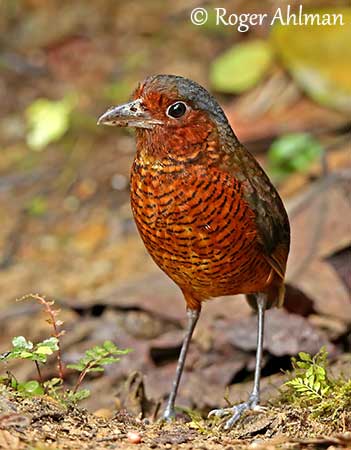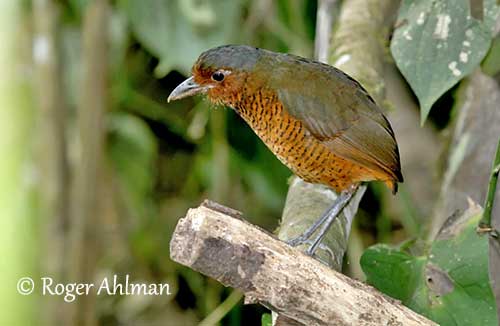
Fr : Grallaire géante
Ang : Giant Antpitta
All : Riesenameisenpitta
Esp : Tororoí Gigante
Ita : Pitta formichiera gigante
Nd : Reuzenmierpitta
Sd : jättemyrpitta
Photographers:
Roger Ahlman
Pbase Galleries Peru and Ecuador & My bird pictures on IBC
Didier Buysse
Vision d’Oiseaux
Tom Merigan
Tom Merigan’s Photo Galleries
William Price
PBase-tereksandpiper & Flickr William Price
Text by Nicole Bouglouan
Sources:
HANDBOOK OF THE BIRDS OF THE WORLD Vol 8 By Josep del Hoyo-Andrew Elliott-David Christie - Lynx Edicions - ISBN: 8487334504
BIRDS OF SOUTH AMERICA – Passerines - by Robert S. Ridgely and Guy Tudor – HELM Field Guides – ISBN: 9781408113424
A GUIDE TO THE BIRDS OF COLOMBIA by Steven L. Hilty and William L. Brown - Princeton University Press – ISBN 069108372X
First description of the nest, nest site, egg, and young of the Giant Antpitta (Grallaria gigantea)
Neotropical Birds – Cornell Lab of Ornithology
CREAGUS@Monterey Bay (Don Roberson)
Wikipedia, the free encyclopaedia
Antpittas and worm-feeders: a match made by evolution?
Giant Antpitta
Grallaria gigantea
Passeriformes Order – Grallariidae Family
INTRODUCTION:
The Giant Antpitta is a mythical, somewhat enigmatic species found in Colombia and Ecuador. It lives in montane evergreen forest and mainly on the ground where it feeds largely on large earthworms.
This species was finally tracked down in the 1990s. Thanks to its song, a fast, quavering, hollow trill, the bird is now encountered more regularly, involving a better study of its habits, range and status.
The Giant Antpitta is threatened by deforestation and destruction of the habitat through logging and agriculture expansion. It is currently listed as Vulnerable. Three subspecies share the restricted range.
The subspecies G.g. hylodroma is displayed on this page.

DESCRIPTION OF THE BIRD:
Biometrics:
Length: 24 cm
Weight: Male gigantea: 204-266 g – Male hylodroma: 254 g
The Giant Antpitta adult of nominate race has brownish upperparts, wings and tail, whereas head sides and underparts are dull rufous with narrow, blackish bars, usually heaviest on flanks.
On the head, the forehead is chestnut, fading into slate grey crown and nape.
The two-tone bill has blackish upper mandible and dark grey lower one. The thick bill is heavy with wide base. The eyes are dark brown. Strong legs and feet are grey.
Male and female are similar.
The juvenile is duller overall than adults. At two weeks old, the head feathers show buffy edges. The plumage is browner than in adults, with broad dark edges to back feathers. The underparts are slightly more rufescent.
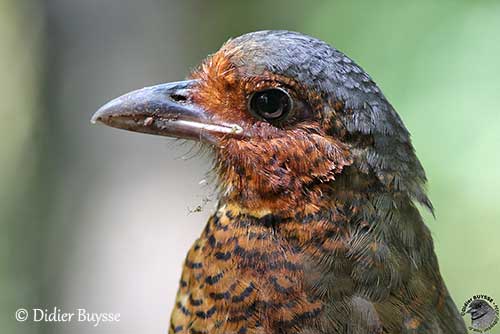
SUBSPECIES AND RANGE:
The Giant Antpitta has three subspecies.
G.g. lehmanni is found in SW Colombia, at head of Magdalena Valley.
This subspecies resembles nominate but it has more olive-brown back and central underparts are more heavily barred.
G.g. hylodroma (displayed) occurs in SW Colombia (Nariño) and Pacific slope of Andes in Ecuador (Pichincha, Cotopaxi province).
This one is the brightest, with rufous-chestnut head, brownish-olive upperparts and rufous-chestnut underparts with narrow, dark bars, although central belly and vent are ochraceous and lack the barring.
G.g. gigantea (described above) is found on E Slope of the Andes of Ecuador (E Carchi and Napo, S to Volcán Tungurahua).
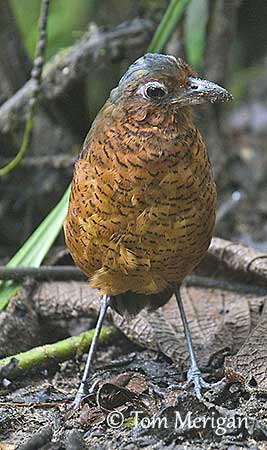
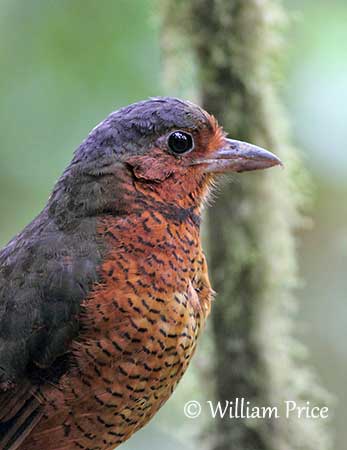
HABITAT:
The Giant Antpitta frequents humid montane forest and mainly swampy and wet areas. It prefers level ground rather than the steep slopes of the Andes.
The three races live at high elevations. Gigantea and Hylodroma occur between 1,200 and 2,600 metres, whereas Lehmanni can be found above 3,000 metres.
CALLS AND SONGS: SOUNDS BY XENO-CANTO
The Giant Antpitta gives very deep rolling series of 60-100 notes increasing in volume and also in pitch at the beginning of the phrase.
On the W slope of the Andes (race hylodroma) the song is a fast, quavering, hollow trill which lasts about 5 seconds. It becomes gradually stronger and has an overall owl-like effect.
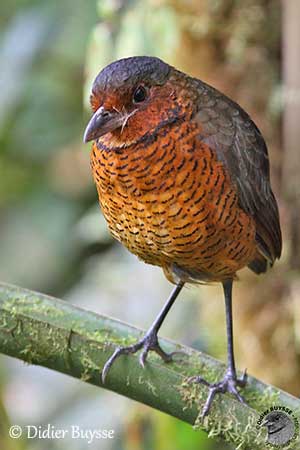
BEHAVIOUR IN THE WILD:
The Giant Antpitta feeds largely on giant earthworms of genus Rhynodrylus found in damp soil. The bird cuts it into pieces of 8 centimetres long to swallow it. It also takes large beetles, grubs and slugs.
It feeds on the ground and probes in wet soil and leaf litter. It often forages near streams and along forest trails. It is usually alone, hopping on the forest floor and pausing for long intervals. It can be seen through the undergrowth and up onto low branches, but it may also forage in clearings at dawn and dusk, close to the forest.
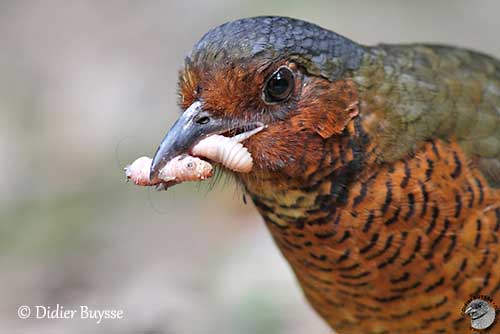
The breeding behaviour of the Giant Antpitta is poorly known. The birds sing before dawn and at late dusk, perched at 2-8 metres above the ground. They often bob the head and flick the wings while adopting an upright stance on their legs placed well on the rear body. They cock the tail momentarily, in conjunction with bobbing and wing-flicking. Between bouts of songs, they often stop to fluff the feathers and they frequently preen.
The territorial disputes are accompanied by calls and may involve direct fighting.
The Giant Antpitta is probably sedentary. It is mostly terrestrial, thanks to the strong legs and feet. Actually, most members of this family are nearly flightless.
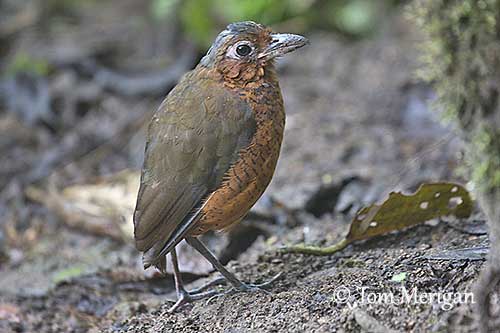
REPRODUCTION OF THIS SPECIES:
As the birds are singing from October to January in NW Ecuador, and in October and March in E Ecuador, we can suggest that this behaviour indicates the breeding season.
From an observation (race hydroloma), one immature and one juvenile were seen in November in Pichincha, and an adult was reported feeding a chick in April in NW Ecuador. In Pichincha, a female was on the nest at mid-January.
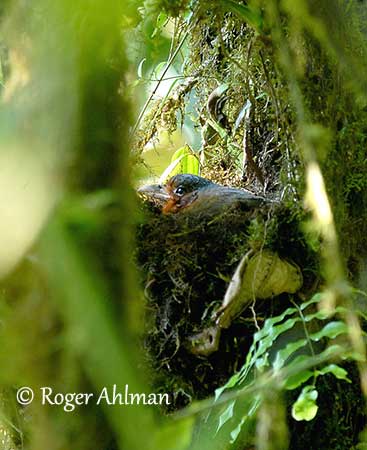
The Giant Antpitta’s nest is a bulky cup of moss, built on top of thick tangle of fine vines anchored to the trunk of a thin tree, at about 7 metres above the ground. The nest-site is in humid montane cloud forest with dense understorey, at around 15 metres from a stream.
The incubation was underway in late December. Two eggs uniformly turquoise were in the nest. The incubation period was roughly estimated at 11-18 days. Both adults share the incubation, while arranging the nest-materials.
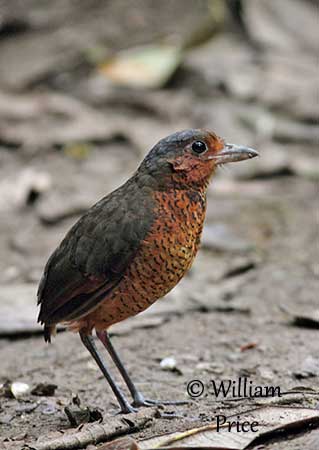
Only one egg hatched. The chick had closed eyes, dark grey skin with fine, blackish-grey down. Two weeks later, the feathers were visible, showing buffy edges, especially on the head. The overall plumage was browner than in adults, with broad, dark edges to back feathers, and slightly more rufescent underparts.
The chick left the nest about 22 days after hatching. It was seen near the nest in the understorey, where it was fed by both adults with pieces of large earthworms. No more information.
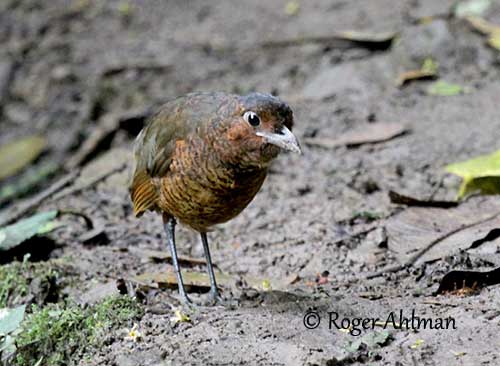
PROTECTION / THREATS / STATUS:
The Giant Antpitta is vulnerable to deforestation throughout its small range. Agricultural expansion at lower to mid-elevations on both slopes of Central Andes since the early 20th century, and loss of the forest at higher altitudes, are the main threats for this species. Habitat destruction continues on the Pacific slope, but also in the W Andes of Nariño in Colombia, and in Pichincha in Ecuador.
The E slope of the Andes in Ecuador has currently more intact forest, although deforestation occurs at lower elevations, around 1,000 metres.
The population is estimated to number 1,000/2,499 individuals, equating to 600/1,700 mature individuals. This population is slowly declining due to habitat loss.
The Giant Antpitta is currently listed as Vulnerable.
